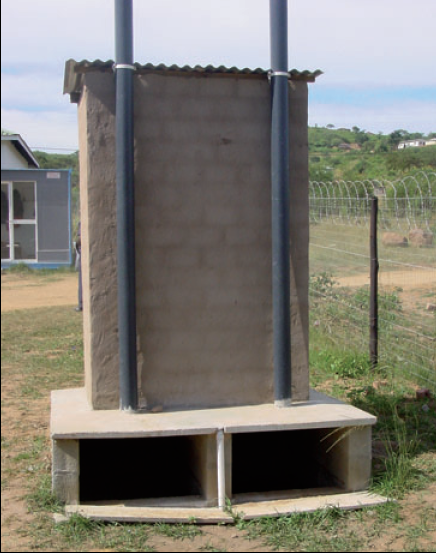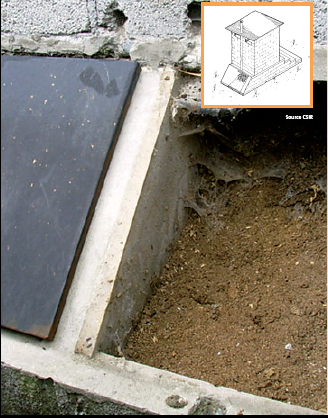Dehydration Vaults
|

|
|
| |||||||||||||||||||||||||||||||
Dehydration vaults are used to collect, store and dry (dehydrate) faeces. Faeces will only dehydrate when the vaults are watertight to prevent external moisture from entering and when urine and anal cleansing water are diverted away from the vaults.


When urine is separated from faeces, the faeces dry quickly. In the absence of moisture, organisms cannot grow and as such, smells are minimized and pathogens are destroyed. Vaults used for drying faeces in the absence of urine have various local names. One of the most common names for this technology is the Vietnamese Double Vaults.
A family of 6 will produce 500L of faeces in approximately six months. For design purposes it is recommended to assume that one person will require almost 100L of faeces storage space every six months. The vaults should be slightly oversized to account for airflow, visitors and the non-even distribution of faeces in the chamber. Each vault is sized to accommodate sixmonths of faeces accumulation which in turn, results in a six month drying time in the out-of-service vault.
Two alternating vaults allow the faeces to dehydrate in one vault while the other vault fills. When one vault is full it is sealed with a lid and the UDDT (U2) is moved to the second vault. While the second vault fills up, the faeces in the first vault slowly dry and decrease in volume. When the second vault is full, it is sealed, the dry material from the first vault is removed and the first vault is then put back into service.
The vaults must be watertight to keep the faeces as dry as possible. Chambers should be constructed of sealed block or formed concrete to ensure that rainwater, surface run-off, greywater and urine are prevented from entering the vaults. Urine can be collected in a bucket and discharge to the ground (garden) or stored in a tank for future transport and use.
A vent is required to help keep the vaults dry and control flies and odours.
| Advantages | Disadvantages/limitations |
|---|---|
| - Can be built and repaired with locally available materials. - Because double pits are used alternately, their life is virtually unlimited. - Good in rocky and/or flooded areas. - Excavation of dried faeces is easier than faecal sludge. - No real problems with flies or odours if used correctly. - Does not require a constant source of water. - Suitable for all types of user (sitters, squatters, washers and wipers). - Low (but variable) capital costs depending on materials; no or low operating costs. - Small land area required. |
- Requires education and acceptance to be used correctly. - Requires constant source of ash, sand or lime. - Requires a place where urine and treated faeces can be used or discharged. - Urine and faeces require manual removal. |
Adequacy
Dehydration Vaults can be installed in almost every setting from rural to dense urban because of the small land area required, the minimal odours and the ease of use. They are especially appropriate for water scarce and rocky areas. In areas that are frequently flooded, Dehydration Vaults are appropriate because they are constructed to be watertight. Furthermore, where there is no plot of land available, the vaults can be installed indoors, which also makes this technology applicable for colder climates (where leaving the house is less desirable).
Health Aspects/Acceptance
Dehydration Vaults can be a clean, comfortable, and easy-to-use technology. When users are well educated and understand how the technology works they may be more willing to accept it as a viable sanitation solution. When the vaults are kept dry, there should be no problems with flies or odours. Faeces from the double vaults should be very dry and relatively safe to handle provided they were continuously covered with material and not allowed to get wet.
There is a low health risk for those whom have to empty or change the urine container. Faeces that have been dried for over one year also pose a low health risk.
Upgrading
There is a risk however when using single vaults, that the top portion of the faeces will not be fully dried and/or hygienized. Single vaults are not recommended (because of the need to handle fresh faeces) and should, whenever possible be upgraded to a double vault.
Maintenance
To prevent flies, minimize odours and encourage drying, a small amount of ash, soil, or lime should be used to cover faeces after each use. Care should be taken to ensure that no water or urine gets into the Dehydration Vault. If this happens, extra soil, ash, lime, or sawdust can be added to help absorb the liquid. Because the faeces are not actually degraded (just dried), dry cleansing materials must not be added to the Dehydration Vaults as they will not decompose. Occasionally, the mounded faeces beneath the toilet hole should be pushed to the sides of the pit for an even drying. Where water is used for cleansing, an appropriate User Interface should be installed to divert and collect it separately. To empty the vaults, a shovel, gloves and possibly a face mask (cloth) should be used to limit contact with the dried faeces.
References
- Elizabeth Tilley et.al (2008). Compendium of Sanitation Systems and Technologies (low res version). Department of Water and Sanitation in Development Countries (Sandec) at the Swiss Federal Institute of Aquatic Science and Technology (Eawag). (Provides a full overview of sanitation systems.)
- (-) Manual del Sanitario Ecologico Seco. Available: http://www.zoomzap.com (A very comprehensive manual on dry chamber construction including detailed instruction and material lists. In Spanish.)
- GTZ (2005). Urine diverting dry toilets programme dissemination (data sheet). GTZ, Germany. Available: www.gtz.de (General overview of Dehydration Chambers with some dimensioning and materials lists.)
- Winblad, U., and Simpson-Herbert, M. (eds.) (2004). Ecological Sanitation - revised and enlarged edition. SEI, Stockholm, Sweden. (A general description of various designs and adaptations, especially Chapter 3.)
- Women in Europe for a Common Future (2006). Urine diverting Toilets: Principles, Operation and Construction. Available: http://www.wecf.de (Photos and explanation of how to build a double vault and superstructure.)
